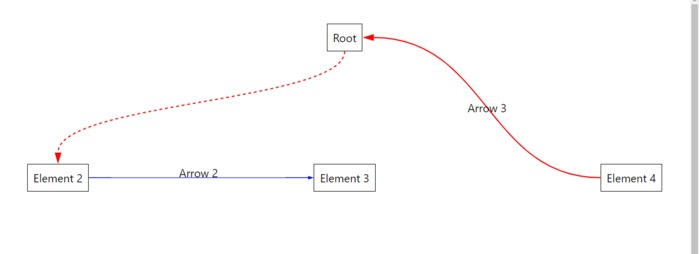
 Data Structure
Data Structure Networking
Networking RDBMS
RDBMS Operating System
Operating System Java
Java MS Excel
MS Excel iOS
iOS HTML
HTML CSS
CSS Android
Android Python
Python C Programming
C Programming C++
C++ C#
C# MongoDB
MongoDB MySQL
MySQL Javascript
Javascript PHP
PHP
- Selected Reading
- UPSC IAS Exams Notes
- Developer's Best Practices
- Questions and Answers
- Effective Resume Writing
- HR Interview Questions
- Computer Glossary
- Who is Who
Drawing arrows between DOM elements in React JS using react-archer
In this article, we will see how to draw flowchart-like arrows to connect different DOM elements in React JS. You can use this feature to create a unique web design. Here we will use the react-archer package to draw arrows to connect the DOM elements.
A DOM element is something like a DIV, HTML, BODY element on a page. You can add classes to all of these using CSS, or interact with them using JS.
Example
First create a React project −
npx create-react-app tutorialpurpose
Now go to the project directory −
cd tutorialpurpose
Download and install the react-archer package −
npm install react-archer
We will use the react-archer package to add arrows and connect the different DOM elements.
Now, insert the following lines of code in App.js: −
import { ArcherContainer, ArcherElement } from "react-archer";
const rootStyle = { display: "flex", justifyContent: "center" };
const rowStyle = {
margin: "200px 0",
display: "flex",
justifyContent: "space-between",
};
const boxStyle = { padding: "10px", border: "1px solid black" };
const App = () => {
return (
<div style={{ height: "500px", margin: "50px" }}>
<ArcherContainer strokeColor="red">
<div style={rootStyle}>
<ArcherElement
id="root"
relations={[
{
targetId: "element2",
targetAnchor: "top",
sourceAnchor: "bottom",
style: { strokeDasharray: "5,5" },
},
]}
>
<div style={boxStyle}>Root</div>
</ArcherElement>
</div>
<div style={rowStyle}>
<ArcherElement
id="element2"
relations={[
{
targetId: "element3",
targetAnchor: "left",
sourceAnchor: "right",
style: { strokeColor: "blue", strokeWidth: 1 },
label: <div style={{ marginTop: "-20px"}}>Arrow 2</div>,
},
]}
>
<div style={boxStyle}>Element 2</div>
</ArcherElement>
<ArcherElement id="element3">
<div style={boxStyle}>Element 3</div>
</ArcherElement>
<ArcherElement
id="element4"
relations={[
{
targetId: "root",
targetAnchor: "right",
sourceAnchor: "left",
label: "Arrow 3",
},
]}
>
<div style={boxStyle}>Element 4</div>
</ArcherElement>
</div>
</ArcherContainer>
</div>
);
};
export default App;
Explanation
The concept is simple. We created an Archer element inside which we have our DOM.
Each Archer element will have a unique ID, and a relation attribute which will indicate many things like −
from which part of source DOM the arrow should generate,
the target DOM where the arrow should point, and
at which side the arrow should point, etc.
All these things will be defined inside the relation attribute.
Output
On execution, it will produce the following output −


